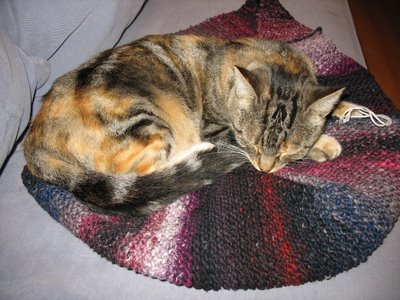FO! [that's Finished Object]
Here is my sweet Chalupa, she's 2yrs old, teeny tiny, and very relaxed [in this picture]. Her interests include yarn, catnip, decimating small critters, sleeping, and wool especially Noro and Fleece Artist. She breaks yarn with her teeth at inopportune moments.
 Lotorp is done! This is the awesomest and fastest-ever bag pattern from Cornelia Tuttle Hamilton's Noro Revisited Book [#3]. Looks like a cat bed in this photo. I loved knitting this bag, it was all knit stitch on 6mm/ 10US, very comfortable and easy.
Lotorp is done! This is the awesomest and fastest-ever bag pattern from Cornelia Tuttle Hamilton's Noro Revisited Book [#3]. Looks like a cat bed in this photo. I loved knitting this bag, it was all knit stitch on 6mm/ 10US, very comfortable and easy. This is what I started with, 3 skeins Noro Iro #19. [Yardage: 132, Fiber Content: 75% Wool, 25% Silk, Stitches: 3, Needle Size: 11, Weight: 100g.] This is an older colorway I won on ebay, all this for under $40 total, shipping included. Thanks Sookie in NY!
This is what I started with, 3 skeins Noro Iro #19. [Yardage: 132, Fiber Content: 75% Wool, 25% Silk, Stitches: 3, Needle Size: 11, Weight: 100g.] This is an older colorway I won on ebay, all this for under $40 total, shipping included. Thanks Sookie in NY! The pattern is well written, there were no problems from start to finish. I did tinker and tweak a few minor details, CTH writes sparse instructions open to interpretation, and I imagine she wants each knitter to use personal discretion. I added 2 more rows to the widest part of each diamond, 6 rows added overall, resulting in a 4 stitch increase in width. Also I chose the M1 increase, twisting the bar between stitches, and I changed the decrease to Sl1 Pwise, K, psso, much easier with bulky yarn.
The pattern is well written, there were no problems from start to finish. I did tinker and tweak a few minor details, CTH writes sparse instructions open to interpretation, and I imagine she wants each knitter to use personal discretion. I added 2 more rows to the widest part of each diamond, 6 rows added overall, resulting in a 4 stitch increase in width. Also I chose the M1 increase, twisting the bar between stitches, and I changed the decrease to Sl1 Pwise, K, psso, much easier with bulky yarn. I wanted the illusion of seamlessness, so I did a couple things to ensure it. The ends of the skeins were matched for smooth blending, no color breaks, and used a provisional crochet cast on, creating live stitches for Kitchener stitch. This photo shows the contrast yarn woven through prior to finishing with Iro, a great trick which saves the "good" yarn from wear and tear while making and fixing mistakes. There were only 12 inches of Iro remaining after weaving the strap, so the rest of the bag was seamed in a different dark wool. It is so nice to use all of the yarn, I am a saver of little bits of yarn and have a significant amount of leftover yarn waiting for Godot.
I wanted the illusion of seamlessness, so I did a couple things to ensure it. The ends of the skeins were matched for smooth blending, no color breaks, and used a provisional crochet cast on, creating live stitches for Kitchener stitch. This photo shows the contrast yarn woven through prior to finishing with Iro, a great trick which saves the "good" yarn from wear and tear while making and fixing mistakes. There were only 12 inches of Iro remaining after weaving the strap, so the rest of the bag was seamed in a different dark wool. It is so nice to use all of the yarn, I am a saver of little bits of yarn and have a significant amount of leftover yarn waiting for Godot.My suggestions for weaving stitches.
- Search for the best possible pictures because for me the visuals are SO IMPORTANT. I like to see a variety of sources just in case I am missing something or the pictures are better in another book. Readers Digest Knitter's Handbook by Montse Stanley has really good visuals, I use it often. I cross check Elizabeth Zimmermann's books, Mary Thomas' Knitting Book and Barbara Walker's Knitting from the Top for verification.
- Use a slippery contrasting yarn to weave the initial stitches. This way the stitches are visible and fixing mistakes is easy. Follow with the real yarn when all is well, and tada: both eyesight and sanity are preserved.



